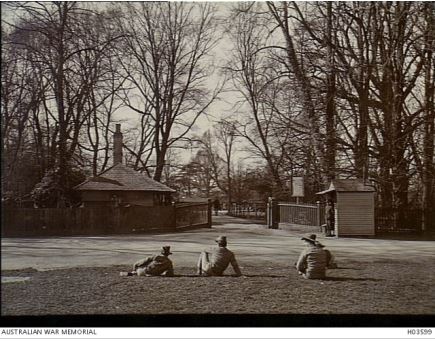Difference between revisions of "2nd Australian Auxiliary Hospital"
From Our Contribution
(→Soldier Patients by date admitted) |
(→Soldier Patients by date admitted) |
||
| (One intermediate revision by the same user not shown) | |||
| Line 100: | Line 100: | ||
* [[Arthur James Allen]] 9 - 24 Sep 1917 | * [[Arthur James Allen]] 9 - 24 Sep 1917 | ||
* [[Thomas Brown Mack]] 10 Nov - 3 Dec 1917 | * [[Thomas Brown Mack]] 10 Nov - 3 Dec 1917 | ||
| + | * [[Frederick Sidney Gladstone]] 13 Nov - 4 Dec 1917 | ||
''1918''<br /> | ''1918''<br /> | ||
| Line 110: | Line 111: | ||
| − | + | [[Category:AIF Units]] | |
[[Category:Hospitals]] | [[Category:Hospitals]] | ||
Latest revision as of 23:10, 9 February 2023
General Information
In August 1916 the St Marylebone School in South Road, Southall, Middlesex was taken over by the Australian Imperial Forces as a military hospital.
The No. 2 Australian Auxiliary Hospital, with 237 beds, received its first patients on 1st September 1916. On 25th September the Beaconsfield School, a high school for girls built in 1908, about 400 yards away, was also commandeered, increasing the Hospital's bed capacity to 470. The operating theatre was fully equipped, with lighting and sterilizers paid for by a generous donation from the Colonial Bank of Australasia. The theatre was located in a detached building, used as an infirmary with 27 beds, which also housed the X-ray Department.
Four months after its opening, some 3991 patients had been treated, of whom only two had died. By the end of the year 450 patients remained.
The Hospital had been a clearing station, accepting excess patients from the No. 1 Australian Auxiliary Hospital at Harefield Park, but in November 1916 it began to specialise in caring for amputees and the fitting of artificial limbs.
A Red Cross store was opened to issue comforts to the patients. The Women's Legion managed the kitchen staff, and a canteen opened in late 1916 run by voluntary workers, mainly Australian women, as a branch of the Anzac buffet.
In January 1917 patients accommodation was increased by 19 beds, giving a total of 489 beds. By the end of August 1917 some 611 amputations had been performed, 46 of which were double; 344 prosthetic legs and 91 arms had been supplied.
The Australian branch of the British Red Cross provided a monthly sum of money to cover travelling expenses for patients going to the theatre, river trips and other outings. It also gave money to improve conditions in the Hospital, such as redecoration of the wards and operating theatre, the purchase of linoleum and mats to match the colour scheme in the wards, and erection of a covered walkway between the St Marylebone and Beaconsfield Schools. At the end of December 1917 a cinema projector was donated by Mr and Mrs Nathan of Grosvenor Square, much to the appreciation of the patients.
Workshops were set up by the Red Cross to help rehabilitate the amputees, but were too few - only 10% of the patients could be accommodated, making the remainder restless and bored. Those who could attend, received training in various skills - telegraphy, electrical mechanics, weaving, boot repair, carpentry, etc - so they would be employable when they returned home. As occupational therapy patients also made rehabilitation embroideries, the Rising Sun being a key image.
The Hospital closed in April 1919. There are five Australians buried in the nearby Southall Havelock Cemetery.
Photos come from National Library of Australia digitised item N 940.475 A938 with the exception of the last one from the AWM HO 3599.
Staff
Soldier Patients by date admitted
Egypt
1915
- Frederick William Scott 14 - 20 Jul 1915
- Frederick Thorneycroft Plant 16 Jul - 17 Aug 1915
1916
- † Frederick William Wallace Moore 20 Jan - 3 Mar 1916
- Stephen Henry Horrocks 1 - 18 Feb 1916
- Victor Thomas Emanuel Compassi 19 Feb 1916 - 9 Mar 1916
England
1916
- William Edward Butcher MM RMG MID 29 Sep - 10 Oct 1916
- James Owen Horrocks 6 Oct - 24 Nov 1916
- Francis Joseph (Frank) Steffan 8 - 14 Nov 1916
- William Stephens 8 - 14 Nov 1916
- Charles Gorringe 15 - 17 Nov 1916
- Jack Hayden Gibson 16 Nov 1916 - 12 Mar 1917
- Charles Richard Irvine MM & Bar 29 Nov - 1 Dec 1916
- † Herbert Frank O'Neill 28 - 30 Dec 1916
1917
- † James Willie Bush 27 Feb - 3 Mar 1917
- John Donald Stalker 14 Mar - 9 Apr
- William Arthur Green 13 Apr - 2 Jun 1917
- James Anthony Parker 21 - 23 May 1917
- Arthur Edward Bingham 7 Jul - 23 Jan 1918
- Arthur James Allen 9 - 24 Sep 1917
- Thomas Brown Mack 10 Nov - 3 Dec 1917
- Frederick Sidney Gladstone 13 Nov - 4 Dec 1917
1918
- William Thomson 16 Jan - 21 Jun 1918
- Wilfred George Bettenay 22 Mar - 30 Aug 1918
- William Percy Matthews 28 Aug - 21 Sep 1918
- Arthur James Allen 9 - 24 Sep 1918
- George Harris 17 Sep 1918 - 24 Apr 1919
- John Esperance Blair 24 Oct 1918





